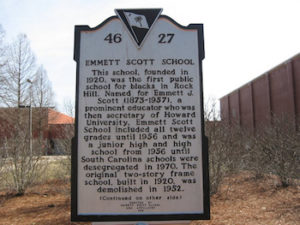
*On this date in 1919, Rock Hill, South Carolina, appropriated funding for Emmett Scott High School, the first South Carolina school for Blacks. This segregated education institution was located in Rock Hill, SC.
Opening in 1920, it fostered quality education for Blacks until 1970. Before 1888, there was no public education in Rock Hill, SC. The first school district charter was issued in 1887, seventeen years after the city received a charter. Before that time, education was carried on by more-or-less private schools supported by patrons and the tuition of pupils.
In 1888, the first public school in South Carolina opened. In 1898, John Coleman Cork became the third superintendent of the Rock Hill public schools; there was no graded school for Negro children. Their education was conducted by four parochial schools, which were: Friendship (Baptist), taught by Reverend M. P. Hall and Reverend M. A. Murray; Clinton institute (Methodist), taught by Reverend J.C. Crockett and Corps; Hermon Presbyterian, taught by Reverend C. M. Young and his wife; and St. Paul's Episcopal taught by Professor Parker. These schools, except Clinton and Friendship, were conducted in the church buildings of their denominations.
They were under the general supervision of the Rock Hill School District Board of Trustees. During the years 1913 - 1914 sessions under the administration of Superintendent Gutner, a petition was presented to the school board by a group of Negro citizens composed of Z. V. Kennedy, Tim Broomfield, Coles Carter, Lee Cauthen, and Tom Archie, asking for the establishment of a central graded school for Negro children.
The petition stated that more Negro children would attend school if free tuition were available. The board considered the petition but took no action at that time. In August 1915, another group of Negro citizens asked the board to give them a free public school. Free tuition for Negro children through the fifth grade was approved in 1916 though no action was taken on the school.
In March 1919, an order was given by the board that arrangements be made to hold an election for the issuance of $75,000.00 worth of bonds to pay indebtedness incurred in making additions to the buildings already in use. Also, these revenues would provide sites and buildings for another grammar school for white children in the western part of the city and a combined grammar and high school for Negro children in the southern part of the city.
This election was held on April 24, 1919, and was carried with 48 votes for and three against. The contract for constructing what was to be Emmett Scott High School was awarded to Mr. Padgett in 1920. Professor Frank Neal, a native of Rock Hill, was elected first principal. After the school was occupied, the question of the name arose. It was common practice at the time for Negro schools to raise money for supplies, teaching aids, etc.
The idea of a two-fold project to name the school while raising needed funds was used. Several groups of teachers and patrons chose the names of outstanding personalities of the day to sponsor in a contest for a name for the school. Among the names used were Booker T. Washington, George Washington Carver, Kelly Miller, and Emmett J. Scott, who had been secretary to Booker T. Washington at Tuskegee and was a high-ranking government worker in Washington, D.C., the Emmett Scott Group, led by one of the teachers, Miss Daisy Picketts, won out. The school was named in his honor.
Emmett Scott was accredited by the S.C. State Department and was allowed to grant state high school diplomas beginning with the class of 1934. There were 11 in the first class of 1923 and 195 in the class of 1966. Two Emmett Scott High School superintendents have been in place since 1920, R. C. Burts (1914 - 1938) and W. C. Sullivan (1934 - 1964). Six principals served Emmett Scott High School: Frank H. Neal (1920 - 1923), L. B. Moore (1924 - 1938), Ralph W. McGuirt (1938 - 1959), W. H. Witherspoon (1959 - 1967), G. C. Land was principal (1967 - 1968) and Samuel Foster (1968 - 1970).